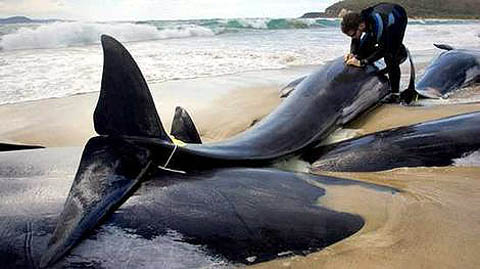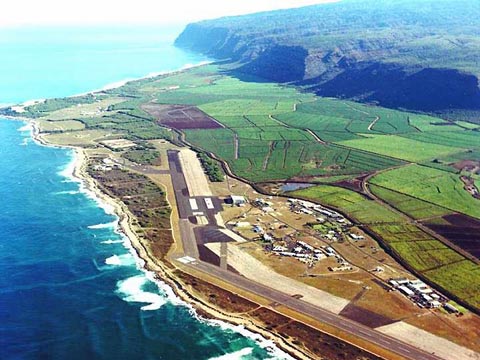INDEX - MILITARY
www.islandbreath.org ID#0615-12
SOURCE: MARK PALMER mpalmer@cal.net
POSTED: 9 JULY 2006 - 4:30am HST
Compromise over RIMPAC sonar use

aircraft carrier USS Carl Vincent docked in Pearl Harbor
| Navy agrees on sonar precautions by Tony Perry 8 July 2006 in The Los Angeles Times Multinational military drills off Hawaii will include steps to protect whales. In return, an environmental group drops its lawsuit. The Navy and an environmental group reached an out-of-court agreement Friday on the issue of whale safety that will allow the Navy to use active sonar during a multinational exercise underway off Hawaii. The Navy agreed to add whale spotters during sonar drills and to expand a buffer zone where it would not conduct the active sonar drills. In exchange, the Natural Resources Defense Council withdrew its lawsuit. The compromise was ratified by a federal judge in Los Angeles. Environmental attorney Richard Kendall called the settlement "a significant step forward in the protection of our oceans." A Navy admiral characterized it as requiring "a small number of additional mitigation measures." On Monday, District Judge Florence-Marie Cooper, sitting in Los Angeles, had blocked the Navy from using the midfrequency active sonar until a July 18 hearing. She had agreed with the lawsuit's assertion that the sonar use would violate the National Environmental Policy Act. The Navy on Wednesday had sought to have Cooper's order quashed by a federal appeals court as endangering national security and military cooperation between the U.S. and its allies. The Rim of the Pacific exercises that began last week involve naval forces from eight countries, including 40 ships, six submarines and 19,000 military personnel. The Navy insists that the active sonar exercises are needed to train sailors to detect stealthy submarines such as those in the naval forces of Iran, North Korea and China. But environmentalists say the sound waves produced by the sonar could injure or possibly kill whales and other marine mammals. Rear Adm. James Symonds, the Navy's director of environmental readiness, in announcing the settlement, said it was "critically important that we have been able to turn active sonar on" for the rest of the RIMPAC exercise, set to run through July 28. Under the agreement, the Navy promised not to use the sonar within 25 miles of the Northwestern Hawaiian Islands Marine National Monument, recently established by President Bush as a nature preserve. The RIMPAC exercise had not been planned for that area, Navy officials said. Also, the Navy promised to have more whale spotters and to order sailors manning detection microphones to listen for whale sounds. The Navy agreed to publicize a marine mammal hotline in Hawaii for residents to report any mammal incidents that might result from the sonar exercises. In 2004, during similar exercises, 150 melon-headed whales moved into a shallow bay off Kauai, apparently spooked by the naval activity. A federal study later blamed the Navy's use of active sonar. Before this year's RIMPAC, the Navy had agreed to mitigation measures suggested by the National Marine Fisheries Service, including spotters and off-limits zones. But after the agency granted an "incidental harassment" permit for the sonar drill, the Natural Resources Defense Council filed the lawsuit, calling those measures inadequate. Navy officials said the new measures could be easily accommodated into the war-game planning and the active sonar might be turned on as soon as today. In an effort to thwart the lawsuit by the Natural Resources Defense Council, the Department of Defense had granted a six-month exemption to the Navy to strictures in the Marine Mammal Protection Act. But Cooper, in issuing her temporary sonar ban, ruled the exemption did not apply to a second environmental law. The issue of sonar's impact on marine life has flared for several years as whales have beached in several areas around the globe after Navy ships have used active sonar. Navy to Limit Needless Harm to Whales National Resource Defense Fund Press Release 7 July 2006 Common Sense Measures in New Accord Include Sonar-Free Buffer Around Newly Created Marine National Monument. Conservation and animal welfare groups today reached a settlement in a hard-fought lawsuit against the U.S. Navy that will reduce needless harm to whales, dolphins and other marine life caused by high-intensity, mid-frequency sonar used during massive international war games now underway in waters off of Hawaii. The settlement comes four days after the Natural Resources Defense Council (NRDC) and other organizations won a restraining order temporarily blocking the use of mid-frequency sonar during the eight-nation Rim of the Pacific (RIMPAC) exercises until better safety procedures were in place. In granting the order, the judge agreed the plaintiffs had presented "considerable convincing scientific evidence demonstrating that the Navy's use of MFA sonar can kill, injure, and disturb many marine species, including marine mammals." Today's agreement, approved by the U.S. District Court in Los Angeles, requires new safeguards, including a sonar-free buffer zone around the Marine National Monument recently created by President Bush, and significant increases in monitoring for marine mammals during sonar drills. "This settlement confirms that measures to protect our oceans can and must be part of the Navy's training for submarine defense," said Joel Reynolds, a senior attorney at NRDC and director of its Marine Mammal Protection Project. "Military readiness does not require, and our laws do not allow, our natural resources to be sacrificed in the name of national defense. That is a false choice, and this lawsuit has vindicated the essential principle that none of us, including the Navy, is above the law." Among other things, the settlement specifically: * Prevents the Navy from using sonar within the newly established Northwestern Hawaiian Islands Marine National Monument or within a 25-nautical-mile sonar buffer zone around it; * Requires all Navy personnel listening through underwater detection microphones to monitor for marine mammals and report the detection of any marine mammal to the appropriate watch station for action; * Requires aerial surveillance for marine mammals during sonar drills and reporting of sightings to a marine mammal response officer; * Requires the Navy to have at least one dedicated and three non-dedicated marine mammal observers on every surface sonar vessel during all sonar drills, and to add an additional dedicated marine mammal observer during the three exercises occurring in channels between the islands; * Requires the Navy to publicize in the local Hawaii press a hotline for reporting marine mammal incidents. "We are pleased that the highest leadership in the U.S. Navy hierarchy has agreed to protective measures never before included in RIMPAC exercises," said Richard Kendall, a senior litigation partner at the Los Angeles law firm of Irell & Manella, co-counsel with NRDC in the lawsuit. "This is a significant step forward in the protection of our oceans." During the last RIMPAC exercise in 2004, there was a mass stranding of more than 150 melon-headed whales in Kauai. A federal government investigation concluded that the Navy's sonar use was the "plausible, if not likely" cause of the stranding. Today's settlement has no bearing on the lawsuit brought by NRDC and other groups last October over the Navy's use of mid-frequency sonar in other training exercises. That lawsuit is still pending in federal court in Los Angeles. Whales exposed to high-intensity mid-frequency sonar have repeatedly stranded themselves and died on beaches around the world (including in Hawaii, Washington State, North Carolina and the Bahamas), some bleeding around the brain and in the ears, with severe lesions in their organ tissue. At lower intensities, sonar can interfere with the ability of marine mammals to navigate, avoid predators, find food, care for their young, and, ultimately, to survive. There is scientific consensus that intense sonar blasts can disturb, injure, and even kill marine mammals. Biologists worry that whales found dying on beaches are only the tip of an iceberg, and that many more are dying at sea. One of the best-documented incidents took place in the Bahamas, in 2000, when 16 whales of three species stranded along 150 miles of shoreline as ships blasted the area with sonar. The U.S. Navy later acknowledged in an official report that its use of sonar was the likely cause of the stranding. The lawsuit was brought by NRDC in conjunction with the International Fund for Animal Welfare, the Cetacean Society International, the Ocean Futures Society, and Jean-Michel Cousteau. Plaintiffs are represented by NRDC and by Richard Kendall, senior litigation partner at the law firm of Irell & Manella in Los Angeles, California, and a team of his colleagues at Irell & Manella. The Natural Resources Defense Council is a national, nonprofit organization of scientists, lawyers and environmental specialists dedicated to protecting public health and the environment. Founded in 1970, NRDC has 1.2 million members and online activists nationwide, served from offices in New York, Washington, Los Angeles and San Francisco. NATURAL RESOURCES DEFENCE COUNCIL http://www.nrdc.org/media/pressreleases/060707.asp contact: Hamlet Paoletti (310) 434-2317 (direct) or Daniel Hinerfeld, (310) 434-2303 (direct); (310) 710-3111 (cell) email: nrdcinfo@nrdc.org |
SOURCE: MARK PALMER mpalmer@cal.net
Navy Seeks Repeal of Judge's Ban on Sonar
8 JULY 2006
- 3:00am HST

logo of the Commander of the US Pacific Fleet
by
Tony Perry on 7 July 2006 in The
Los Angeles Times A judge's order
banning active sonar during a naval exercise off Hawaii will damage
national security, embarrass the United States in front of allies,
and make it difficult to form future coalitions to "deter aggression,"
Navy lawyers charged in a federal appeal to lift the ban. |
Navy to Use Passive Sonar in Exercise Stop
the Navy Noise!
Mark
J. Palmer (mpalmer@cal.net)
Contacts US
House of Representatives: Hawaii,
2nd District US Senator
from Hawaii: You can also ask for your Representative's office by calling the Capitol Switchboard at (202) 224-3121; or look up your Representative online at: http://www.house.gov/
|
SOURCE: JUDY DALTON dalton@aloha.net
Temporary reprieve for whales
4 JULY 2006 - 2:45am HST

Navy
denies as many as130 pilot whales killed by sonar offTasmania in2005. For
more click image.
compiled by Judy Dalton on 3 July 2006 Whales, dolphins
and other marine mammals just got a reprieve today through July 18th.
Please come to PMRF today/this evening to get our message out to the
Navy. We want to see this temporary restraining order become permanent. by Gregg
K. Kakesako on 30 June 2006 for the Honolulu Star-Bulletin
Please go to Natural Resources Defense Council web site www.nrdc.org to see what other action you can take and listen to and watch the short video Lethal Sounds. Mass stranding and mortality events associated with mid-frequency sonar exercises have occurred in North Carolina; Washington State; the Canary Islands; Madeira; the U.S. Virgin Islands; and in Greece. One of the best documented incidents occurred in the Bahamas in 2000 when 16 whales of three species stranded along 150 miles of shoreline as ships blasted the area with sonar. The U.S. Navy later acknowledged in an official report that its use of sonar was the likely cause of the stranding. Mid-frequency sonar can emit continuous sound well above 235 decibels, an intensity roughly comparable to a Saturn V rocket at blastoff. Marine mammals have extraordinarily sensitive hearing, and there is no scientific dispute that intense sonar blasts can disturb, injure, and even kill them. Whales exposed to high-intensity mid-frequency sonar have repeatedly stranded and died; some bleeding from the eyes and ears, with severe lesions in their organ tissue. At lower intensities, sonar can interfere with the ability of marine mammals to navigate, avoid predators, find food, care for their young, and, ultimately, to survive. Some stranding reports may underestimate sonar harm because they do not account for whales that die at sea and are never found. |
SOURCE: DIANA LABEDZ DianaLaBedz@aol.com
The Whales are Crying
2
JULY 2006 - 2:30am HST

aerial view of PMRF Navy Base at 'Barking
Sands" is strategic communication center for RIMPAC
by Diana LaBedz on 1 July 2006 Who:
The Sierra Club, Surfrider Foundation The US Navy refuses
to stop using mid frequency sonar. The Bush administration gave them
the OK to go forward in spite of the evidence that sea life is being
harmed. The sound is up to 10,000 times louder than a rocket launch.
All it does is detect old diesel submarines. The sound tortures and
often, kills whales, dolphins and other sea life that use their ears
to find food, mate and protect themselves from harm. The lawsuit filed
by Natural Resources Defense Council continues, with an application
for temporary restraining order re sonar use in the RIMPAC exercises
is still pending, based on violation of NEPA. We are waiting for a
decision possibly on Monday. Diana
LaBedz |
SOURCE: JASON DONOVAN jason@divinekauai.com
RIMPAC 2006 has begun
27
JUNE 2006 - 1:00am HST

harbor porpoise killed bysonar of USS Shoup in Haro Straight 5
March 2003 and examined by
NOAA Fisheries National Marine Mammal Laboratory (NMML) at Sand
Point, Seattle, WA
.
by
Hope Atz 26 June 2006
|
Pau
